Notebooks
— 2020-07-27
- bullet journal: a paper os
- tools
- journaling in practice
- the blank spread
- daily log
- monthly log
- yearly log
- custom: daily exercise log
- custom: daily meals/groceries
- custom: sleep log
- social
- tidying
- events
- conclusion
- further resources
Ever since I picked up programming in 2013 I haven't really stopped. Weekdays, weekends, evenings. I've spent much of my adult life obsessing about programs. But that's come at a cost: over the years I've started to realize what I've been trading for the time spent working on projects. And I realized I needed to change course.
Desiring change is a useful starting point; but it needs to be followed up by execution. My default mode of doing things was: "drop everything, focus on the new thing", but that was the root of the problem I was trying to address 1. I realized this wasn't enough, and what I needed was the ability to formulate plans and the ability to review.
The answer for me has been to adopt a framework: a notebook, pen, and ruler. In this post I want to share more on how that's worked for me.
I made a list of things I wanted to do in Jan 2018. That year I only managed to do the first thing on the list. My 2018 GitHub contribs are a testament to the absurd amount of time spent. Looking back at this list two years later was confrontational and made me realize that I needed to actively change my approach if I ever wanted to make progress on the things I cared about.
bullet journal: a paper OS
In January I first learned about "bullet journalling" through the Pick Up Limes channel on YouTube. The whole video is worth a watch, but this passage really stood out to me:
I genuinely didn't know how I functioned before this system. Because I was someone who had notes everywhere. [...] It always felt like there was information coming at me from every direction, but at the same time I couldn't really find anything when I was looking for it. But now, with this system, I feel like I've got a little built-in secretary always reminding me of what I need to do.
Someone was telling me that a notebook could act as a secratary? That sounded amazing, and I wanted to learn more! 2 So I read the book "The Bullet Journal Method". In it the author Ryder Carroll lays out a framework for taking notes he describes as an "OS for managing your life".
The core tennets of the system are:
- A system to quickly take notes and categorize them ("rapid logging").
- A time structure to organize lists by (daily, monthly, yearly).
- Key moments when and how to interact with the journal.
A key reason why this has to be on paper is that the expression of these ideas is inherently personalized. Every person has different requirements for what they need to track, and a physical notebook is about the only medium that can provide this degree of flexibility. It's a system that serves the needs you have here and now, and adapts to your needs over time.
Another quality of paper is that every action on it takes effort. You cannot automate a notebook; the most convenient you can make it is to create a framework. This ensures you have an active relationship with your notes. Nothing will automatically be added. Nothing will automatically be carried over. Every entry is deliberate. And this provides opportunity to reflect and prioritize.
Admittedly I had to overcome a kneejerk reaction to dismiss paper as the right interface to take notes. I suspect this may be due to some ingrained tech exceptionalism, but I went into it thinking: "How can I turn this into an app later?" The answer is: it wouldn't work well. Paper is infinitely versatile and allows adapting layouts to be best suited for you, at a given time. It's an interface that evolves with you. And no app can replace that.
Tools
It's possible to bullet journal as long as you have a notebook and pen. But these are the tools I use:
- Notebook: LEUCHTTURM1917 A5 hardcover dotted — 18 EUR
- Pen: Stabilo point 88, fine 0.4mm — 2 EUR
- Ruler: Rumold transparent — 1 EUR
I estimate I go through about 3 notebooks per year, estimating my equipment cost to be about 6 euros per month. I also highly recommend using a transparent ruler if you can find one, as I found it easier to use than opaque variants.
Journaling in practice
Did I say journals are customized to the owner's needs? There is no right way to journal; but here's how I do it.
The blank spread

Each page in the journal is empty when you start out. I was so daunted by it the first time I started: I was afraid of making mistakes and doing things wrong. A blank page has no system yet; no relationship to any other page either. And that's okay. We get to define that, and the most important part is to start.
Daily log
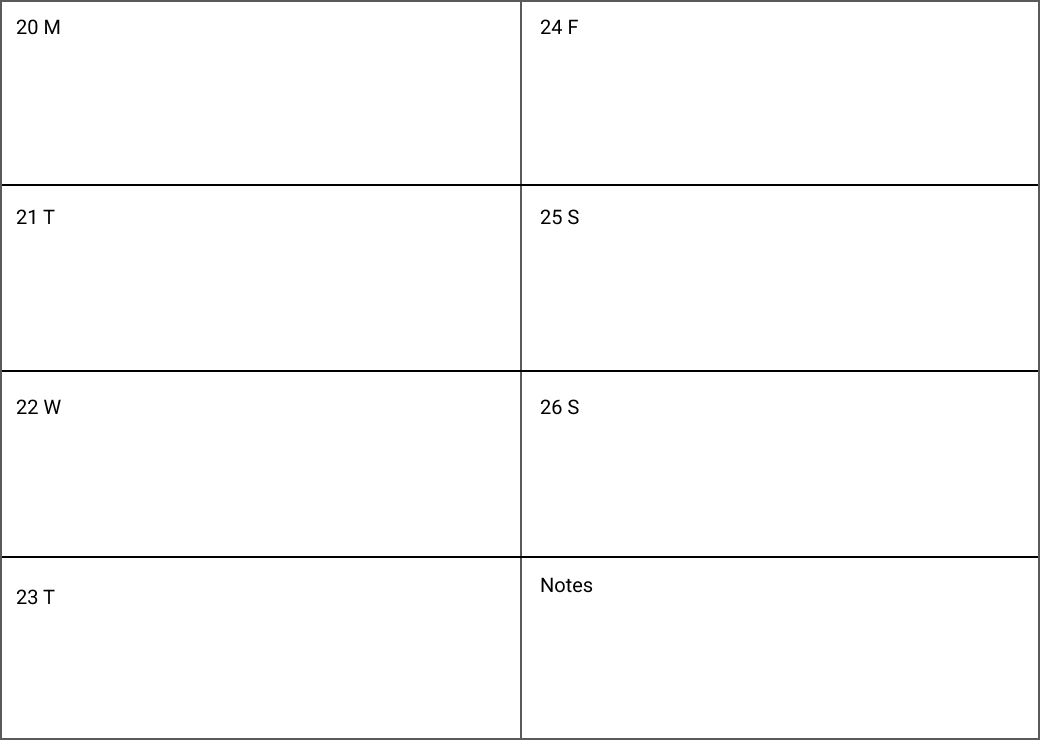
Every Sunday I plan my week ahead. I create a new daily log spread, and I copy over all dates and tasks for the week over from my monthly log. And I copy over the tasks from the week before that I need to do this week. This means when Monday rolls around I don't start at a deficit, but instead already know what I need to work on.
My daily journal is a two-page spread that starts on Monday and ends on Sunday. This leaves 1/8th of the pages over to write notes, which I usually use to note extra tasks for the week, or tasks to carry over to the next week.
I start each day with a list of things I need to do (including meetings and things to read). And end the day with a list of things I have done. If I've missed something I carry it over to another day, or file it in my monthly log.
Monthly log
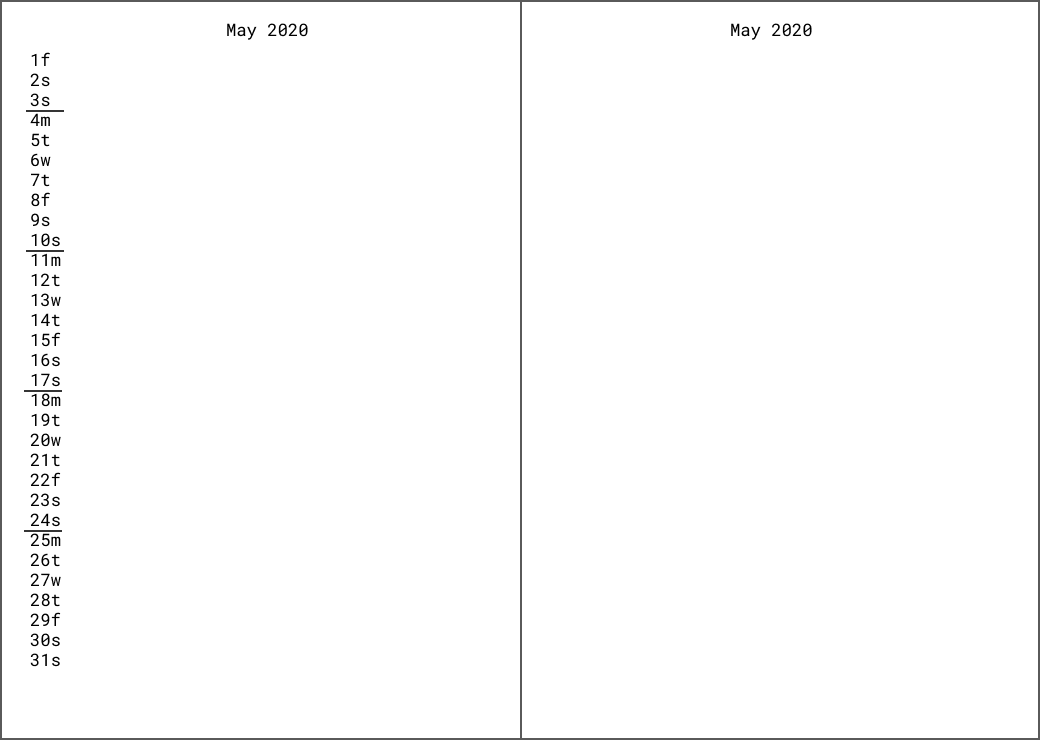
The monthly log provides a wider breakdown of the month. These are the 14 pages after the yearly log. That is 6 months + 2 pages to capture events after that. The idea is that we'll run out of notebook pages before we reach the end of the 6-month period.
On the left hand of each page there's a line per day, with little markings to delimate each week. And on the right side there's space for todos for the month. I like to plan this spread out at the start of the month. I filter and carry over uncompleted tasks from the prior month. And copy over entries from the yearly log.
The monthly log is also a good place for habit tracking. On the right side of the left page I have a column marked "e" (for "exercise") that I add a small x on the day of whenever I've done exercise. This allows me to see at a glance how I've been doing (17 entries so far this month).
I've recently started experimenting with task prioritization on the right page. On the bottom half of the page I create two columns: one with things (projects?) I'm currently working on. And one with goals (projects?) I would like to be doing. Assuming I need to drop something in order to make time for something new, I can then figure out how to break it down further.
Yearly log
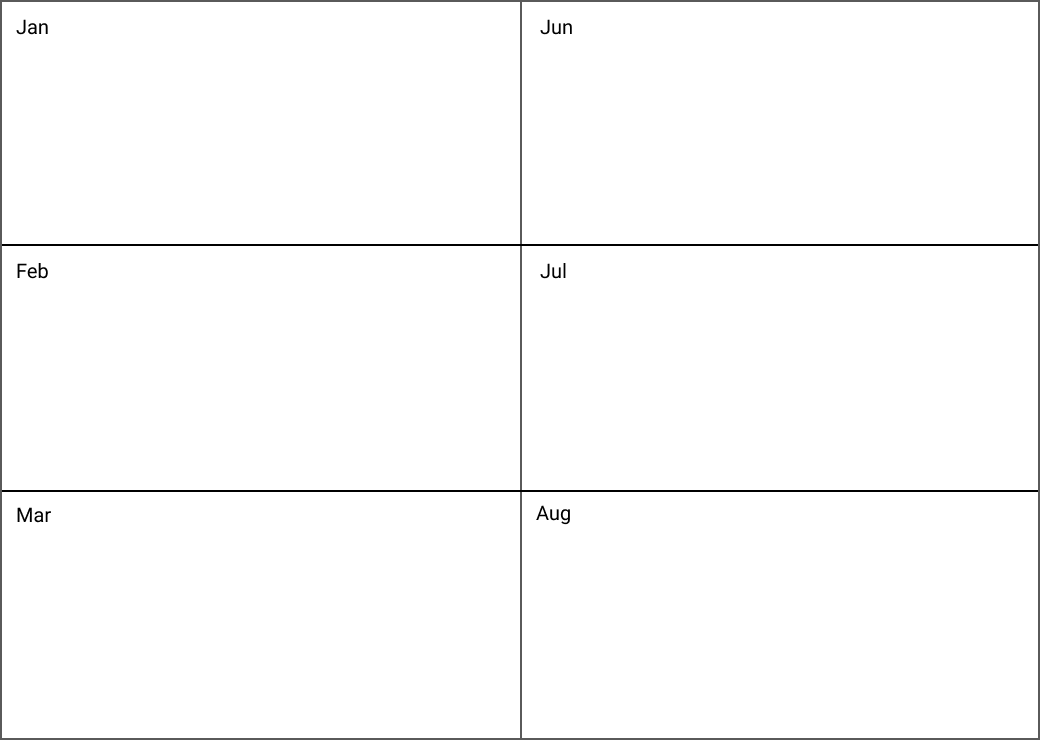
The first 4 pages in any notebook make up the yearly log. This is an overview of each month; with 3 months per page. Here I write down important events, anniversaries, birthdays, and major upcoming events. I fill this out whenver I get a new notebook, filtering and carrying over the yearly log from an earlier notebook. It also serves to plan year-scale events such as holidays on.
When first starting a notebook this is a fun section to start with. Look up national holidays. Ask friends when their birthdays are. Schedule and spread out vacations. Look up conference days, book releases, movie releases.
I usually only consult the yearly log at the start of the month to carry over events to the monthly log, and whenever I find out about a friend's birthday 3. But hopefully I'll find some other uses for the yearly log in the future — this is a useful timescale to look at things through, and one I don't nearly do enough.
For any pal reading this who's casually mentioned their birthday. I've been keeping track, hehe.
Custom: Daily exercise log

The spreads I've covered so far are fairly standard. They're almost 1:1 implementations of Ryder Carroll's base templates. I like them because they're easy to create and take minimal upkeep.
But one project that didn't quite fit in that mold was tracking and planning exercise. Or well; the way I solve it was by creating another weekly log that I use to plan and track exercise in.
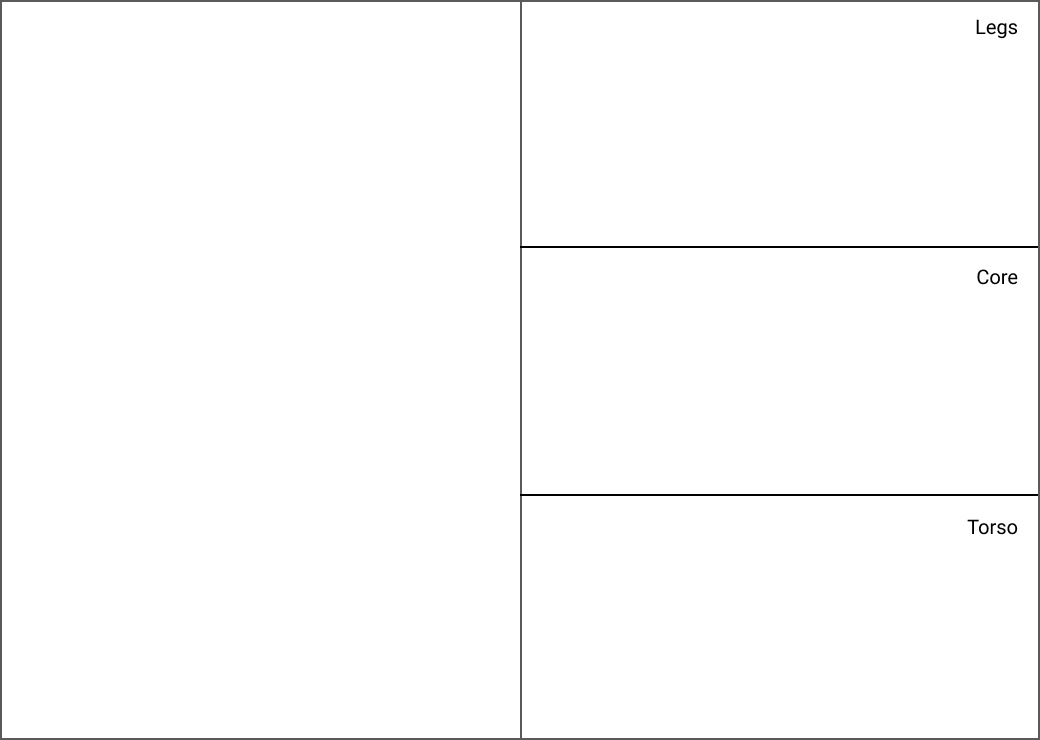
At the front of my notebook I reserve two pages for for exercises. The left page contains a collection of sets I can do. And the right page individual exercises catagorized per muscle group. This much resembles the meals/groceries spread, but for exercise.
Custom: daily meals/groceries
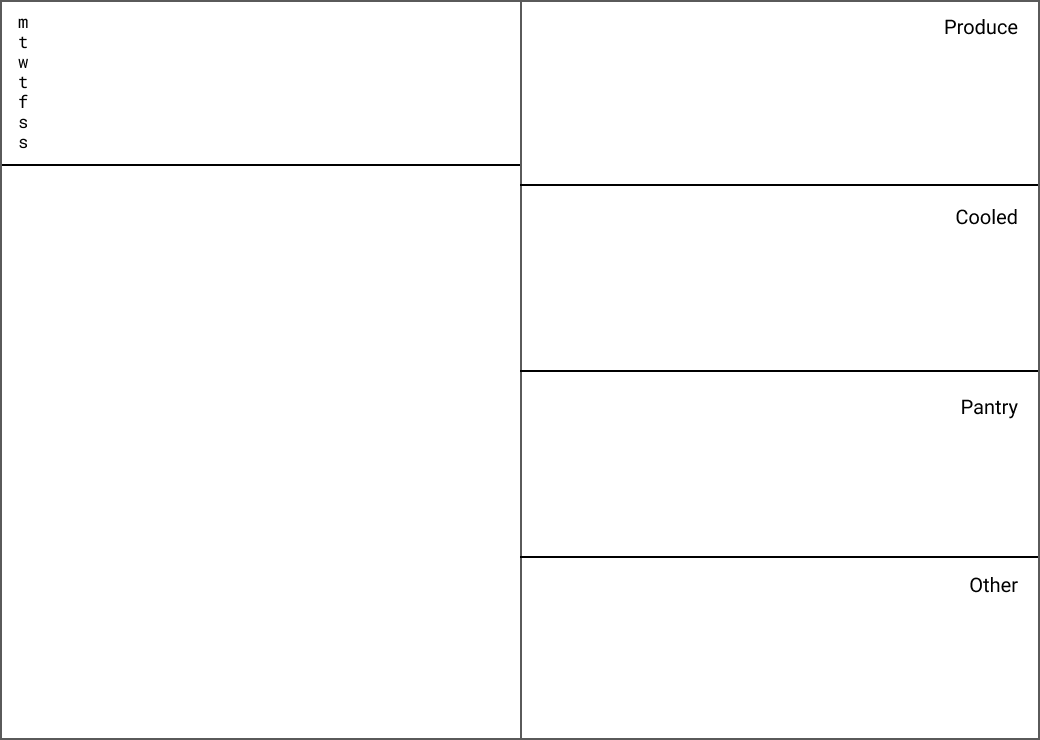
I realized last year that my partner and I were ordering in food several times a week. The reason for that was because we couldn't find the time to cook, even for fun on the weekends. So I wanted to find a way to lower the barrier.
The answer ended up being a combination of several things: decide what to cook ahead of time, make sure we're stocked, and keep a clean cooking surface at all times. This is still a work in progress, but being able to plan meals and groceries is a useful tool to have.
The way we do this is by creating a spread with on the left-hand side an overview of meals for the week: per-day breakdown at the top, and individual recipes at the bottom. And an overview of ingredients on the right-hand side.
On a good week I sit down with my partner and talk about what we want to cook that week. Then I do a full index of what we need to prepare those meals with. I then cross out what we already have in the house from the list. And finally take a look at the list of staples in the front of the notebook and check whether we're missing any. We then end up with a decent list of things we need to buy for the week, and are ready to do a grocery run.
Sometimes we still unexpectedly make plans with pals, or have meetings run over that prevent cooking meals. But if planned well you roll over meals, or postpone them for the week after. This takes some practice though.
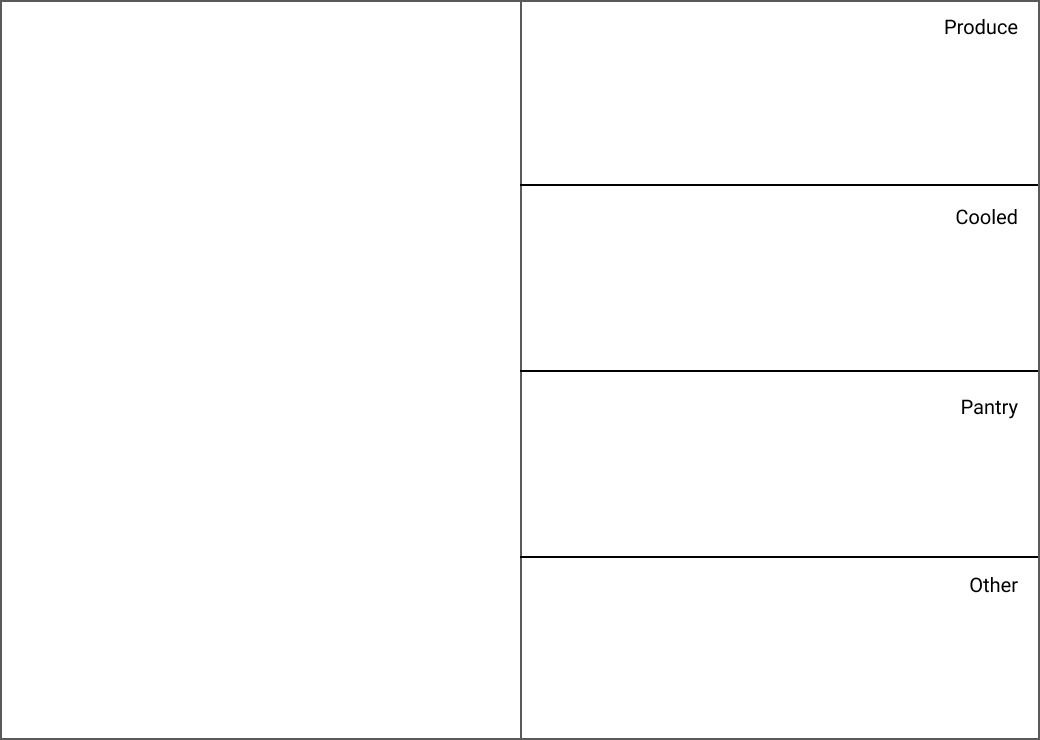
Figuring out what to buy from the store can be a tedious process. So I like to keep a list of staples in the front of the notebook (somewhere after the monthly logs, before the first daily log). It's a useful reference that allows me to quickly check whether I'm missing something, or I can check it for inspiration on what to cook.
Custom: sleep log

One thing I started tracking earlier this year was my sleeping patterns. I noticed I had trouble falling asleep, trouble waking up, and felt pretty sad a lot of the time. I figured this would be helpful to track. I no longer track it (yay good sleep!), but the image above is my sleep for the month February. 4
Probably the worst day that month was when I hit 4 and then 5 hours of sleep, then went for dinner with friends, and had to organize 20 people to get to a bar. I also caught wind the contract I was negotiating unexpectedly fell through. The whole week was pretty rough. But it probably would've been worse if I hadn't been aware of my sleeping patterns.
Social
Something new I've started, and am still working on, is keeping track of interactions with friends and acquiantances. There are people who I used to interact with regularly but for whatever reason don't interact with enough. And other people who I wish I was closer with, but am not.
This requires active planning, tracking, and considering. I know how nice it is when a friend I haven't heard of in a while reaches out — it doesn't have to be much really. I want to be that person for others. The friend who gets in touch; who reaches out.
I'm still experimenting with the right system for this, and reading up on material how to be better (I just started "we should get together"). Perhaps I'll figure something out here and have something to share in the future.
Tidying
Something I've desired to do for a few years has been to be better around the house. Clean more often, do more chores. Part of this has been communication with my partner. Part doing research on how to actually keep a house tidy (konmari actually worked for me). And much of it I've been able to track through my notebook.
I now clean the windows once every 3 months. I've created a daily habit of cleaning up in the mornings. I keep a list of chores to do when I have time available. This has gradually helped me get better around the house, which is not only nice for the people I live with. It makes me feel more calm and in touch with where I spend most of my time.
Events
In the two months before the pandemic my partner and I started going to shows more. Every month I'd look up events around Berlin, and we'd plan them in to go see throughout the month.
Because it's so easy to go through the same loop every day. Days turn into weeks. Weeks into months. And in my case: it feels like little has changed for me in the last 3 years. Making an active effort to do new things is something I wanted to do.
Unfortunately the pandemic has thrown a bit of a wrench into this, but I still wanted to share this actually worked really well for as long as I did it. With lockdown measures decreasing in Berlin I probably should cautiously try something like this again: even if it's just parks to visit, areas to go, or recipes to try.
Conclusion
This has been an overview of how I use my notebook to track much of my life. I started doing this 8 months ago, and I feel it's helped me gain more control of my life. Perhaps you'll find this useful too.
Further Resources
- Bullet Journal on YouTube
- The Bullet Journal Method book (The audiobook is ~4 hours)